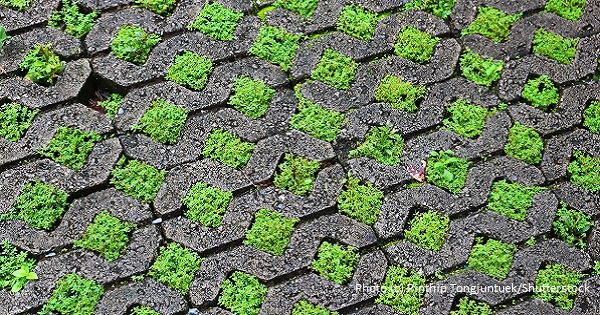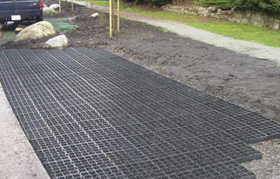
Your Sustainable Home:
Replacing Hardscaping with Non-Polluting Surfaces
That Let the Rain Soak Through
by Rolf Priesnitz
| Asphalt surfaces are hard on the environment and human health, but there are alternatives that let the rain soak through rather than run off, and that don't emit dangerous chemicals. |
If you are building a driveway, pathways, patio, or other surfaces around your home (known as “hardscaping”), please consider the effect on the environment of impervious surfaces and choose a green alternative.
The Problems
Conventional asphalt driveways and solid, impervious patio and walkway surfaces like poured concrete and sealed tiles (and even highly compacted soil) create a number of environmental problems.
They collect many types of pollutants (such as oil and other fluids from vehicles, in the case of a driveway), which run off into storm sewers, overwhelming the infrastructure and polluting lakes and rivers, rather than infiltrating into the ground.
Not only that, but a common coal-tar-based asphalt sealer used to prolong the life and improve the appearance of driveways and other asphalt surfaces has been found to be a significant health and ecosystem threat. Research detailed in a recent article in the journal Environmental Science & Technology, has found that Sealcoat made from a refined coal-tar pitch emulsion has about one thousand times more polycyclic aromatic hydrocarbons (PAHs) than regular asphalt emulsion. The the soil and homes adjacent to the surfaces coated with coal-tar-based sealant were found to have high concentrations of PAHs, both after application and three years on. Other research indicates that children living in homes adjacent to sealed pavement were likely exposed to about fourteen-fold higher doses of PAHs than those living adjacent to unsealed or non coal-tar sealant treated pavement.
Large expanses of solid paving also contribute to the “heat island effect.” This is the phenomenon where urban and suburban temperatures are one to six degrees C (two to ten F) hotter than surrounding rural areas due to the absorption of the sun’s energy rather than it being reflected by vegetation, light-colored roofs, and pavement.
The Alternatives
Permeable or porous pavement, on the other hand, allows rainwater to filter into the ground while providing a durable surface for vehicles and foot traffic.
The least expensive option for patios or walkways is plain concrete pavers. The pavers are solid, but if they’re spaced correctly, water can drain between them. Pavers are placed over a bed of sand or gravel, which filters water before it percolates into the soil. Porous concrete unit pavers are also available.

A solid but permeable parking surface is being created with an interlocking grid system that will be interplanted with groundcover. |
The concrete industry promotes something called “pervious concrete pavement,” which is a concrete mixture that contains little or no sand. Instead, water and cement materials are used to create a paste that forms a thick coating around aggregate particles. This results in a system of highly permeable, interconnected voids that drain quickly.
Another option is the use of one of the many available interlocking permeable systems that create a grid of either concrete or recycled high density polyethylene. Gravel, sand, groundcover, or grass is then placed in the spaces inside the grid, keeping the material in place but allowing water to pass through.
Crushed stone is suitable for some uses, such as driveways and low-use pathways. It has the added attraction of being inexpensive, but can be high maintenance; laying it over plastic defeats the purpose of letting water flow through, so you’ll need to weed occasionally.
Another attractive and semi-permeable treatment for patios and walkways is to install flat stones, pavers, pieces of broken concrete, or tiles over a bed of sand and gravel. This technique, known as dry laying, allows water to pass through the openings between each stone or paver. A groundcover or moss growing in the cracks can be quite attractive.
Permeable systems can cost more to lay than asphalt or poured concrete and, depending on the material, may require more maintenance. But the results are more aesthetically pleasing, more environmentally responsible, and may save money in the long run.
Rolf Priesnitz is the founder and Publisher of Natural Life Magazine, and also has over forty-five years of experience in the construction industry.
|

